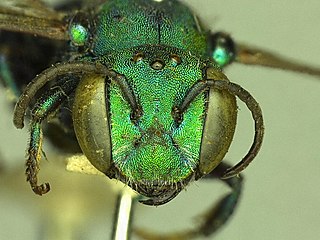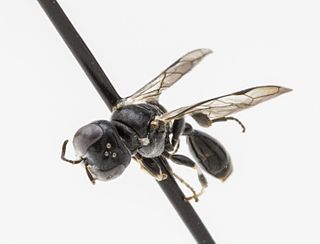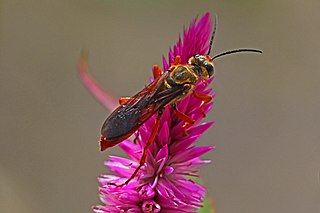
Megachilidae is a cosmopolitan family of mostly solitary bees whose pollen-carrying structure is restricted to the ventral surface of the abdomen. Megachilid genera are most commonly known as mason bees and leafcutter bees, reflecting the materials from which they build their nest cells ; a few collect plant or animal hairs and fibers, and are called carder bees, while others use plant resins in nest construction and are correspondingly called resin bees. All species feed on nectar and pollen, but a few are kleptoparasites, feeding on pollen collected by other megachilid bees. Parasitic species do not possess scopae. The motion of Megachilidae in the reproductive structures of flowers is energetic and swimming-like; this agitation releases large amounts of pollen.

Hoplitis anthocopoides is a species in the family Megachilidae, in the order Hymenoptera . The distribution range of Hoplitis anthocopoides includes Africa, Europe & Northern Asia, and North America.
Trachusa fontemvitae is a species of leafcutter, mason, and resin bees in the family Megachilidae. It is found in North America.
Osmia glauca is a species in the genus Osmia, in the family Megachilidae . It is found in North America.
Stelis perpulchra is a species of insect in the family Megachilidae. It is found in Central America and North America.

Stelis is a genus of kleptoparasitic bees in the family Megachilidae. There are at least 100 described species in Stelis.

Osmia foxi is a species of mason bees in the family Megachilidae. It is found in New Mexico and southeastern Arizona in the United States and in Sonora, Mexico.

Osmiini is a tribe of leafcutter, mason, and resin bees in the family Megachilidae. There are about 19 genera and at least 1,000 described species in Osmiini.

Sphex nudus, the katydid wasp, is a species of thread-waisted wasp in the family Sphecidae.
Triopasites is a genus of cuckoo bees in the family Apidae. There are at least two described species in Triopasites.

Endelomyia aethiops, the roseslug, is a species of common sawfly in the family Tenthredinidae.

Endelomyia is a genus of common sawflies in the family Tenthredinidae. There are at least two described species in Endelomyia.

Andrena pruni, the cherry miner, is a species of mining bee in the family Andrenidae. It is found in North America.

Myrmica americana is a species of ant in the family Myrmicinae. It can be found in all states in the U.S.A. besides Alaska, Hawaii, Oklahoma, Oregon, and Washington. It can also be found in all Canadian provinces besides New Brunswick, Yukon Territory, Northwest Territories, and Nunavut.

Rhopalum clavipes is a species of square-headed wasp in the family Crabronidae. It is found in Europe & Northern Asia and North America.

Odontomachus clarus is a species of ant in the family Formicidae.

Sphex jamaicensis is a species of thread-waisted wasp in the family Sphecidae.

Coelioxys hunteri, or Hunter's cuckoo-leaf-cutter bee, is a species of hymenopteran in the family Megachilidae.

Megachile pseudobrevis, the southeastern little leaf-cutter bee, is a species of hymenopteran in the family Megachilidae.

Lithurginae is a subfamily of woodborer bees in the family Megachilidae.















